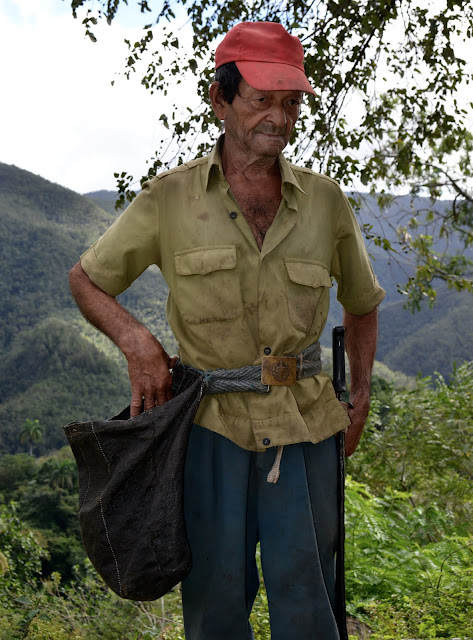Photo by Tim Gallagher
It
rained hard much of the night but it had eased by dawn, so we began our hike,
making our way up the treacherous, rain-slick, red-clay trails, following El
Indio to the pine forest above.

Photo by Tim Gallagher
Martjan
began his double-knock protocol as we reached the high pine forest, strapping
the resonator box to a tree and pounding the hinged dowels to create the Bam-bam sound of a drumming Campephilus woodpecker. This was the
first time anyone had used a device of this kind in Cuba; the sound echoed
through the forest. At the end of the drumming session, Martjan held up a small
mp3 player with a speaker and broadcast the calls of an Ivory-billed
Woodpecker—kent, kent-kent, kent—recorded
in northern Louisiana in 1935 by a team of researchers from the Cornell Lab of
Ornithology.

Photo by Tim Gallagher
After
each session, which lasted about half an hour, we hiked to the next spot, 500
meters away, and tried again—Bam-bam—waited
about 25 seconds, then Bam-bam again.
We tried this 4 times today. The last time, I stayed behind to hear what it
sounds like from a distance, and I was amazed at how realistic it is—just like
the double-knocks of Robust Woodpeckers (a relative of the Ivory-bill) I heard
last year in the Atlantic Forest of Argentina. And the sound carries a
remarkably long way. I couldn’t hear the kent
calls at all—and these were previously the only acoustic lure researchers had
to attract the birds. The double-knock device extends our range significantly,
and we are eager to try it out in prime Ivory-billed Woodpecker areas as soon
as our permits arrive.
Photo by Tim Gallagher
We
heard high-pitched chirps coming from the leaf litter, and El Indio soon pulled
out a tiny amphibian to show us. It was one of the smallest frogs in the
world—an eastern Cuban endemic called Eleutherodactylus
iberia. Cuban
researcher Alberto R. Estrada discovered the species during Martjan’s 1993 Cuba
expedition. El Indio held it up for me to take a picture. It was smaller than
his thumbnail.
Photo by Tim Gallagher
During our dawn-to-dusk hike, we asked
El Indio if he has ever seen an Ivory-billed Woodpecker, and he astounded us
with a description of four birds he saw when he was seven or eight years old in
the early 1980s. They were very close to here, he said, in a canyon leading up
into the mountains. He was with his father when he saw the birds, he said. He
described the appearance of the birds and their calls perfectly. This news is
very welcome. In the distant past, Ivory-bills had lived in lowland areas in
Cuba, but most of them vanished as the forests were cut in the 19th century.
The only sightings since the 1940s took place in mountain pine forests. If the
birds are still nesting in canyons with tropical forests, it certainly raises
the chances of their survival. When we asked him whether he believes the
Ivory-bill might still exist, El Indio said yes but that the only way to prove
it would be to launch a major two-month-long expedition, scouring the mountains
and valleys of this entire area, including all of Humboldt National Park and
more.

Photo by Tim Gallagher
The view of Bahia de Taco from a mountain ridge. We had spent from dawn to dusk hiking from the beach up to the high pine forest and back down again on the slippery trails, sometimes having to bushwhack with machetes.

























